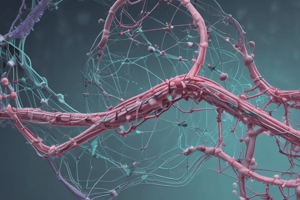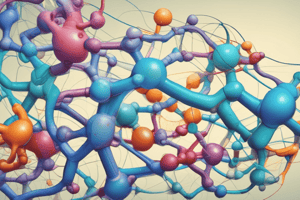Podcast
Questions and Answers
How does the sequence of amino acids primarily determine a protein's function?
How does the sequence of amino acids primarily determine a protein's function?
- By influencing the rate of protein synthesis.
- By determining the protein's solubility in water.
- By dictating the protein's three-dimensional structure. (correct)
- By establishing the protein's interaction with mRNA.
Denatured proteins retain their original functional shape but lose their activity.
Denatured proteins retain their original functional shape but lose their activity.
False (B)
What type of bond is primarily responsible for stabilizing the double helix structure of DNA?
What type of bond is primarily responsible for stabilizing the double helix structure of DNA?
Hydrogen bonds
The backbone of nucleic acids consists of alternating sugar and ______ molecules linked by covalent bonds.
The backbone of nucleic acids consists of alternating sugar and ______ molecules linked by covalent bonds.
Match the following amino acid properties with their characteristics:
Match the following amino acid properties with their characteristics:
How do enzymes facilitate biochemical reactions?
How do enzymes facilitate biochemical reactions?
Ribosomes are responsible for transcribing mRNA into a DNA sequence.
Ribosomes are responsible for transcribing mRNA into a DNA sequence.
What structural feature distinguishes purines from pyrimidines?
What structural feature distinguishes purines from pyrimidines?
How do chaperonins facilitate proper protein folding?
How do chaperonins facilitate proper protein folding?
RNA contains deoxyribose sugar and thymine instead of uracil and is typically double-stranded.
RNA contains deoxyribose sugar and thymine instead of uracil and is typically double-stranded.
Describe the role of tRNA in the process of translation.
Describe the role of tRNA in the process of translation.
A peptide bond is formed between the amino group of one amino acid and the ______ group of another, releasing water.
A peptide bond is formed between the amino group of one amino acid and the ______ group of another, releasing water.
Match the following types of RNA with their primary functions:
Match the following types of RNA with their primary functions:
Which of the following is NOT a primary function of DNA?
Which of the following is NOT a primary function of DNA?
What is the direct effect of R groups on protein structure and function?
What is the direct effect of R groups on protein structure and function?
The complementary base pairing in DNA ensures accurate replication and transcription of genetic information.
The complementary base pairing in DNA ensures accurate replication and transcription of genetic information.
Which of these elements is a primary component of organic molecules?
Which of these elements is a primary component of organic molecules?
Which of these molecule types can form a cellular membrane?
Which of these molecule types can form a cellular membrane?
When writing out chemical reactions, what must one take care to do?
When writing out chemical reactions, what must one take care to do?
Which of the following is NOT a function of carbohydrates?
Which of the following is NOT a function of carbohydrates?
Pure water has all the following properties except:
Pure water has all the following properties except:
What is the function of a buffer?
What is the function of a buffer?
The name 'Carbohydrate' comes from which property?
The name 'Carbohydrate' comes from which property?
A polar covalent bond results in slight positive and negative charges on different parts of the molecule, creating the potential for hydrogen bonding.
A polar covalent bond results in slight positive and negative charges on different parts of the molecule, creating the potential for hydrogen bonding.
Flashcards
Chaperonins Role
Chaperonins Role
Assist protein folding and can refold misfolded proteins.
Protein Secondary Structure
Protein Secondary Structure
Stabilized by hydrogen bonds between backbone atoms.
DNA functions
DNA functions
Information storage, replication, and transmission.
RNA vs DNA
RNA vs DNA
Signup and view all the flashcards
tRNA function
tRNA function
Signup and view all the flashcards
Enzymes Role
Enzymes Role
Signup and view all the flashcards
mRNA vs rRNA
mRNA vs rRNA
Signup and view all the flashcards
R Groups Effect
R Groups Effect
Signup and view all the flashcards
Purines vs. Pyrimidines
Purines vs. Pyrimidines
Signup and view all the flashcards
Amino Acid Sequence & Function
Amino Acid Sequence & Function
Signup and view all the flashcards
Hydrogen Bonds in DNA
Hydrogen Bonds in DNA
Signup and view all the flashcards
Primary Protein Structure
Primary Protein Structure
Signup and view all the flashcards
Protein Denaturation
Protein Denaturation
Signup and view all the flashcards
Enzymes & Activation Energy
Enzymes & Activation Energy
Signup and view all the flashcards
Phospholipids in Membranes
Phospholipids in Membranes
Signup and view all the flashcards
Hydrophobic vs. Hydrophilic AA
Hydrophobic vs. Hydrophilic AA
Signup and view all the flashcards
Carbon
Carbon
Signup and view all the flashcards
Phospholipid
Phospholipid
Signup and view all the flashcards
Balancing Chemical Equations
Balancing Chemical Equations
Signup and view all the flashcards
Carbohydrate functions
Carbohydrate functions
Signup and view all the flashcards
Properties of Pure Water
Properties of Pure Water
Signup and view all the flashcards
Function of a Buffer
Function of a Buffer
Signup and view all the flashcards
Carbohydrate Name Origin
Carbohydrate Name Origin
Signup and view all the flashcards
Covalent Bonding
Covalent Bonding
Signup and view all the flashcards
Study Notes
- Organic molecules all contain carbon.
Protein Folding and Structure
- Chaperonins help proteins fold correctly and refold misfolded ones.
- Hydrogen bonds between backbone atoms stabilize the secondary structure of proteins, including alpha helices and beta sheets.
- The four levels of protein structure are primary, secondary, tertiary, and quaternary.
- Protein denaturation occurs when proteins lose their structure and function due to extreme conditions
- Denatured proteins lose their functional shape and may become inactive after their structure is disrupted.
- Temperature changes disrupt hydrogen bonds and other interactions, leading to protein denaturation and loss of function.
- Understanding protein structure is crucial for determining how proteins function and interact in biological systems.
- R groups determine the properties of amino acids, influencing protein folding, stability, and function.
- The specific sequence of amino acids determines a protein's three-dimensional structure and, consequently, its function.
- The primary structure of a protein is the linear sequence of amino acids in a peptide chain.
- Lysine is a positively charged amino acid that forms additional peptide bonds and participates in various biochemical reactions.
Nucleic Acids
- The primary functions of DNA include information storage, replication, and transmission.
- Complementary base pairing ensures accurate replication and transcription of genetic information.
- Hydrogen bonds between complementary bases stabilize the double helix structure of DNA.
- Purines (adenine and guanine) have a two-ring structure, while pyrimidines (cytosine, thymine, and uracil) have a single-ring structure.
- The backbone of nucleic acids consists of alternating sugar and phosphate molecules linked by covalent bonds.
- RNA contains ribose sugar and uracil, and is primarily single-stranded, unlike DNA.
- mRNA carries genetic information from DNA to ribosomes, while rRNA is a component of the ribosome itself, aiding in protein synthesis.
- The main types of RNA are mRNA (messenger RNA), tRNA (transfer RNA), and rRNA (ribosomal RNA), each serving roles in protein synthesis.
Enzymes and Biochemical Reactions
- Enzymes catalyze biochemical reactions by lowering the activation energy required for the reaction.
- Enzymes reduce activation energy by stabilizing the transition state and bringing reactants closer together.
Protein Synthesis
- Protein synthesis occurs through transcription of DNA to mRNA and translation of mRNA to a polypeptide chain.
- Ribosomes facilitate the translation of mRNA into a polypeptide chain during protein synthesis.
- tRNA carries specific amino acids to the ribosome and matches them to the codons in the mRNA.
Amino Acids and Peptide Bonds
- Only L-amino acids are used in proteins across all life forms, suggesting a common evolutionary origin.
- Optical isomers, or enantiomers, can have different biological activities.
- A peptide bond is formed between the amino group of one amino acid and the carboxyl group of another, releasing water.
- Hydrophobic amino acids repel water and tend to be buried in the protein core, while hydrophilic amino acids attract water and are often found on the protein surface.
Water
- Water's critical traits include being a polar molecule capable of hydrogen bonding and acting as a universal solvent.
- Pure water has all the following properties except the ability to dissolve lipids.
- The property that the elemental formula of the molecule is (CH2O)n gives "Carbohydrate" its name.
Phospholipids and Cell Membranes
- Phospholipids form a bilayer that serves as the fundamental structure of cell membranes, creating a barrier between the interior of the cell and its environment.
- Phospholipids are the molecule types that can form a cellular membrane.
Other Key Points
- A polar covalent bond results in slight positive and negative charges on different parts of the molecule, creating the potential for hydrogen bonding.
- Atoms can be combined into new, distinct molecules by covalent bonding.
- Helium is not commonly used by living things.
- The function of a buffer is to stabilize the pH of a solution to a particular level.
- The catalysis of chemical reactions of a cell is NOT a function of carbohydrates.
- When writing out chemical reactions, one must balance both the atoms and electrons on each side of the arrows.
- Phosphorylation can modify protein structure and function, often regulating enzyme activity and signaling pathways.
Studying That Suits You
Use AI to generate personalized quizzes and flashcards to suit your learning preferences.




